Cornwall and Devon- part 1
After being in London for about 7 weeks, we are finally getting out and seeing some countryside! Our original plan for bank holiday weekend was to go and check out the festival in Edinburgh but we left it a bit late for that and couldn't find any accomodation (unless we wanted to share a single bed!) So instead we are doing a bit of a road trip to the SouthWest of the UK with our friends Hayley and Kirk from NZ.
Day 1
Louise had been coping a fair bit of mockery from her English colleagues who couldn’t believe we were actually considering driving all the way to Cornwall in Bank Holiday traffic. She was warned that the only sights we would see would be those of the cars in front of us. And for the first few hours, this wasn’t far from the truth. The most direct route to our destination was with the A303 but this wasn’t moving anyway in a hurry so we took a detour down the coast. Here, the smell of the country was evident but the traffic moved a lot faster. Kirk and Warren were keen to catch the All Black’s game so we stopped in a town in Dorset and drove around a bit looking for a pub, but as you could probably guess, they were only showing Football. Where’s a ‘Walkabout’ when you need it? We even stopped at a petrol station and were told that we might find the game playing at the Castle and Horse. After doing a few more circuits of the town and stopping for directions again, we gave up and continued on with our journey on the ‘B’ roads. These roads are quite unlike anything I’ve seen. They are lined with hedges and are super narrow. Despite being 2-way roads there is no way 2 cars could fit side by side on these roads. Hayley commented that the tracks on their farm were wider. Luckily we had a small car (a Fiat that made a loud clicking noise when the air con was on.)

Hayley and Kirk had a BBQ a few weeks previously when their friend Patty talked about this huge giant in Dorset that we should go and see. Hayley was imagining a statue in rock and wasn’t too impressed to discover that the Cerne Giant is actually an ancient etching of a man in a chalk mountain. Apparently it is one of Britain’s best known chalk figures. It stands at 55m tall and is between a few hundred and a couple of thousand years old. So we took our photo then drove back to the town of Cerne Abbas for lunch. The town was quite small and quaint. As we stopped outside an old church to look at some houses that could have been on the set of Lord of the Rings, a black Labrador befriended us and followed us inside a restaurant. It was kind of strange to be served a Meatball sub by a 14-year-old American boy in a small English town but it was tasty. As was the mushroom Hayley had for lunch. J
 We decided to drive through Dartmoor National Park, which didn’t really feel like a National Park at all. There were small towns in the park and like Desert Rd, parts of it are used for military training. The only thing which gave it it’s parky feeling were the sheep which were free to roam, even on the roads. We stopped at Postbridge, a tiny village with a granite clapper bridge across the river Dart dating from the 13th century. That's Warren standing on the bridge to the left. We stopped again another hour or so onwards but didn’t stay long as the hypothermia was beginning to kick in. That's us freezing our butts off in the photo below. It was easy to see why the park is known for its wild, bleak countryside and is the home to Sherlock Holmes’ notorious foe – the Hound of Baskerville. We drove through Princetown, England’s highest town and home of Dartmoor prison, built in 1809 to house French and American prisoners of war. It is now one of Britain’s most infamous high security jails. The dreary building surrounded by high barbed wire fences was surprisingly centrally located and gave the town a foreboding, depressed kind of feeling.
We decided to drive through Dartmoor National Park, which didn’t really feel like a National Park at all. There were small towns in the park and like Desert Rd, parts of it are used for military training. The only thing which gave it it’s parky feeling were the sheep which were free to roam, even on the roads. We stopped at Postbridge, a tiny village with a granite clapper bridge across the river Dart dating from the 13th century. That's Warren standing on the bridge to the left. We stopped again another hour or so onwards but didn’t stay long as the hypothermia was beginning to kick in. That's us freezing our butts off in the photo below. It was easy to see why the park is known for its wild, bleak countryside and is the home to Sherlock Holmes’ notorious foe – the Hound of Baskerville. We drove through Princetown, England’s highest town and home of Dartmoor prison, built in 1809 to house French and American prisoners of war. It is now one of Britain’s most infamous high security jails. The dreary building surrounded by high barbed wire fences was surprisingly centrally located and gave the town a foreboding, depressed kind of feeling.
We arrived at Lauceston at 8.15pm to a somewhat flustered B&B host who told us she almost relet our room (woops – guess we should have called). After a brief chat when she mentioned that none of us sounded like New Zealanders (could be explained by the Schwezfin family who were the last ‘NZers’ to sign the visitors book) and not to expect to see her smiling in the morning after getting up at 7 to make us breakfast, we headed into Lauceston town centre. We chose Lauceston (pronounced ‘Lawn-sin’ not ‘Lawn-ces-ton’ as we were all calling it) for its location only, not because it really had anything going for it. We found a café for dinner and somehow must have managed to offend the host because his service was terrible and he bordered on being rude, but the food was OK.
Day 2
As anticipated from all the comments in the visitor’s book, the full English breakfast that our host had to get up so early to make, was delicious. Well, Warren thought it was, but it was a bit
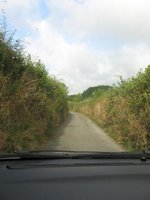 too ‘fried’ for Louise. The sausages, locally made by the butcher, and the bacon were favourites with Kirk and Warren. After farewelling the English version of Grandma Strother we tackled some more back roads to Boscastle. At one stage the road got so narrow that Kirk was able to wind down the window and pick some blackberries from the hedge on the opposite side of the road. That's a picture of one of the roads to the right. It took 2 of us reading maps and all of us on ‘sign watchout’ to navigate these roads but we made it. On the road we saw heaps of really old yet modern homes with range rovers parked outside. There were heaps of massive wind turbines on the fields, like what they will have in Wellington soon.
too ‘fried’ for Louise. The sausages, locally made by the butcher, and the bacon were favourites with Kirk and Warren. After farewelling the English version of Grandma Strother we tackled some more back roads to Boscastle. At one stage the road got so narrow that Kirk was able to wind down the window and pick some blackberries from the hedge on the opposite side of the road. That's a picture of one of the roads to the right. It took 2 of us reading maps and all of us on ‘sign watchout’ to navigate these roads but we made it. On the road we saw heaps of really old yet modern homes with range rovers parked outside. There were heaps of massive wind turbines on the fields, like what they will have in Wellington soon.Boscastle was a small, quaint fishing village with lots of character. (Photo below) The village still looked to be asleep when we arrived and sadly, the witch museum was closed. There was a little sheltered port with small fishing boats with what looked like crayfish or lobster pots. It was icy cold but we got great views of the celtic sea. An essential part of tourism for Warren is tasting the local foods so we bought a few Cornwall Damsons which dispelled the notion that all things purple are tasty. (Damsons looked to be a cross between a grape and a plum).
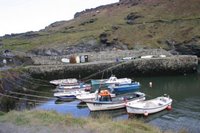
From Boscastle (which doesn’t actually have a castle) we headed to Tintagel, supposedly the town where King Arthur was born or at least his legend was created. Tintagel is famous for its castle ruins, dating back to Arthur’s times. The ruins were really
 interesting and located on an island with great views of the ocean. But great views means heights were involved and there were a few stairs to climb. Then the sun came out, and being dressed for London weather not Cornwall weather, we were roasting. The castle and settlement ruins had ledges that went right out to the ocean. As we hadn’t seen any
interesting and located on an island with great views of the ocean. But great views means heights were involved and there were a few stairs to climb. Then the sun came out, and being dressed for London weather not Cornwall weather, we were roasting. The castle and settlement ruins had ledges that went right out to the ocean. As we hadn’t seen any 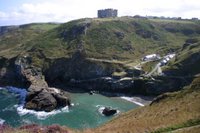 castles or English ruins we spent quite a while here exploring. On our way out of Cornwall, Kirk asked a local guide where we could sample a true Cornish pasty. Cornish Pasties are available everywhere, but surely you have to experience a food at its place of birth? Now for a short detour on the history of the pasty. The pasty dates back to the tin mining era of Cornwall. A true traditional pasty would have meat and potatoes at one end and jam or fruit at the other. The end of the pasty would be stamped with the initials of the miner and this would be the last part to be eaten, so if you wanted to save some for later, you could identify your pasty. But legend tells that the initialled corner would be dropped in the mine for the gremlins to eat for good luck. It probably did bring the miners ‘good luck’ too because by not eating the pastry that they had handled, they were reducing their arsenic intake.
castles or English ruins we spent quite a while here exploring. On our way out of Cornwall, Kirk asked a local guide where we could sample a true Cornish pasty. Cornish Pasties are available everywhere, but surely you have to experience a food at its place of birth? Now for a short detour on the history of the pasty. The pasty dates back to the tin mining era of Cornwall. A true traditional pasty would have meat and potatoes at one end and jam or fruit at the other. The end of the pasty would be stamped with the initials of the miner and this would be the last part to be eaten, so if you wanted to save some for later, you could identify your pasty. But legend tells that the initialled corner would be dropped in the mine for the gremlins to eat for good luck. It probably did bring the miners ‘good luck’ too because by not eating the pastry that they had handled, they were reducing their arsenic intake.Anyway, the traditional sweet and savoury pasty is no longer
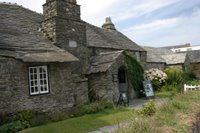 available, but as recommended by our local guide we ordered a steak pasty at the local bakery. It was so delicious, filled with thinly sliced meat, onions and swede in a soft pastry that wasn’t greasy like the London ones. Judging from the comments Hayley and Kirk looked to be regretting their decision to share one and Warren too was tempted to go back and get another one. The photo to the left is the Historic Post Office of Tintagel, very cool looking place but we didn't have a chance to check out the inside.
available, but as recommended by our local guide we ordered a steak pasty at the local bakery. It was so delicious, filled with thinly sliced meat, onions and swede in a soft pastry that wasn’t greasy like the London ones. Judging from the comments Hayley and Kirk looked to be regretting their decision to share one and Warren too was tempted to go back and get another one. The photo to the left is the Historic Post Office of Tintagel, very cool looking place but we didn't have a chance to check out the inside.With pasties in hand, we continued on to Newquay – the surfing capital of the UK. It took about 2 hours to get there and had the feel of the Mt at summer. It was relaxed but busy and shirtless brits and bikini clad girls walked through the town (even though it wasn’t really that hot). It was surprised how appealing the beach actually looked (Louise
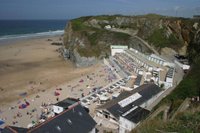 was picturing a shingle beach from a Mr Bean summer special I saw a few years back). The beach was very English- it was bizarre. There were these little huts with umbrellas on them-see the photo to the left. People were swimming and Warren reckoned he would have had a swim too but after driving around for 20 mins we couldn’t find a park (a reoccurring theme of our short break) so continued on our journey to St Ives.
was picturing a shingle beach from a Mr Bean summer special I saw a few years back). The beach was very English- it was bizarre. There were these little huts with umbrellas on them-see the photo to the left. People were swimming and Warren reckoned he would have had a swim too but after driving around for 20 mins we couldn’t find a park (a reoccurring theme of our short break) so continued on our journey to St Ives.


0 Comments:
Post a Comment
<< Home